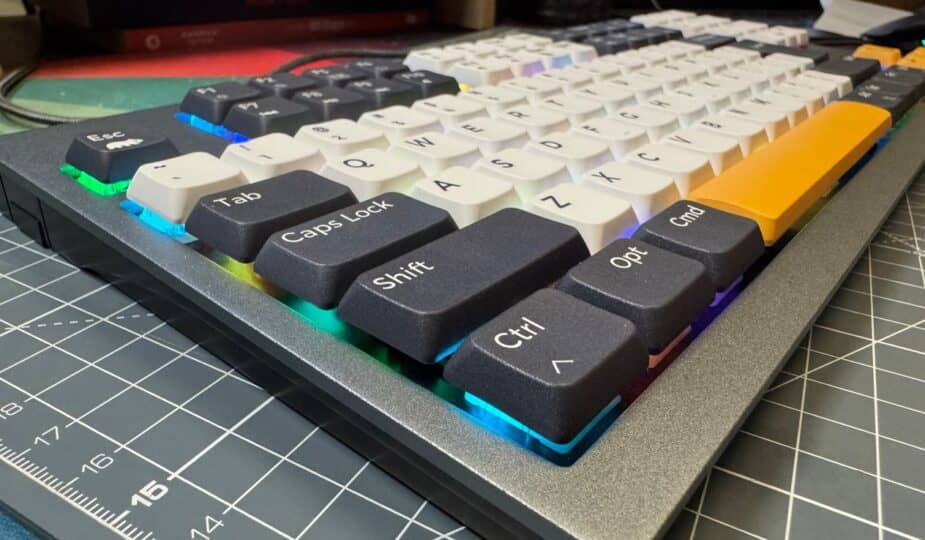Wombat Willow Pro
 0 Facebook x.com Reddit
0 Facebook x.com Reddit
Wombat Willow Pro Mechanical Keyboard
3.5/5 Buy on Amazon
The Wombat Willow Pro is a full-fledged mechanical keyboard with a narrower than usual width, and even has low profile switches. This is an interesting choice if you are willing to learn a very unusual layout.
Power users are often quite picky about the keyboard they use. This can include, for example, whether it takes the form of a chiclet-style keyboard, a membrane keyboard, or a mechanical keyboard.
With choice also comes the need to sacrifice one feature for another. One such thing can be size, as having a smaller keyboard can mean reducing the number of actual keys you can press.
While you can try to live with a smaller keyboard with fewer keys, the Wombat Willow Pro goes in the other direction. It gives you all the keys you could want, but without the width of a full-size keyboard.
Wombat Willow Pro Review – Design and Layout
The most obvious thing about the Wombat Willow Pro is its size and layout. The whole concept of the keyboard is key density, which means cramming a full set of keys into as small a package as possible.
In a typical full-size layout, you'll have the main block of letter keys on the left, the arrow keys and some utility keys a little to the right, and the number pad on the right. This usually creates a fairly wide keyboard, much wider than the current trend of keyboards that are ditching things like the number pad to create a smaller package.
In the case of the Willow Pro, it's trying to have its cake and eat it too. To some extent, it manages to pull off a Schrodinger's bakery quite well.
Wombat Willow Pro Review: The Layout Is Unusual, But You Still Have All the Keys You Need
A full keyboard has 104 keys in the ANSI layout and 105 in the ISO layout. For the Willow Pro, it's squeezed into 102 keys, including a larger Enter key in the ISO layout.
The layout uses two tricks to minimize its width, both of which rely on expanding the footprint along the other axis.
The function keys, utility keys, and some of the number pad's math function keys are squeezed into two rows at the top, doubling the function row. The remaining number keys are pushed up above the arrow keys.
The end result is a layout that's a little intimidating for inexperienced users due to the sheer density of the keys and their placement. The raised position of the number pad feels unwieldy, but in use, it's actually quite usable for occasional use.
The end result is a keyboard that's 14.5 inches wide and 6.33 inches deep. At 1.73 inches thick, it's also fairly thin compared to other mechanical keyboards on the market, though its 2.2 pound weight brings it back in line with the rest of the market.
The keyboard is made up of an aluminum top case that tries hard to fit into Apple’s aesthetic, and does so well. The black plastic base is less attractive, but it’s an element you won’t spend much time looking at.
Wombat Willow Pro review: adjustable feet and part of the ruler markings.
On the bottom, there are two fixed rubber strips at the front and two adjustable feet at the back. These rear feet are unusual, as you remove them, flip them upside down to reveal the raised foot, and reinstall them magnetically if you want to raise the typing angle.
It’s a pretty neat design idea, and the magnets are certainly strong enough to keep the feet in place well beyond the occasional desk jolt.
Curiously, there’s a 30cm ruler printed on the base. It's an odd choice to put markings like that on the base of the keyboard, but at least it's accessible if you need to measure something.
On the right side is a cutout for the included wireless dongle, which is, again, held in place magnetically.
On the back is a USB-C port for charging and physically connecting to a Mac. There are also two switches for switching between Windows and Mac layouts and for turning the keyboard on and off.
Wombat Willow Pro Review: USB-C is conveniently located, but the switch labels are hard to read.
The switch labels are a bit hard to see, as they are in black ink on a black background. But unless you plan on moving the keyboard between desktops often, this won't be a big deal.
Wombat Willow Pro Review – Features
To start, the Willow Pro is a keyboard that can connect to your Mac or PC in a number of ways. Obviously, via the USB-C port, which can also charge the 1,000mAh battery built into the peripheral.
You can also use the included adapter, which operates at over 2.4GHz, to connect via the USB-A port on your host device.
Finally, you can also connect the keyboard to your Mac or iPad using Bluetooth 5.0. Since you can define up to three Bluetooth connections and switch between them using the function keys, you can connect the Willow Pro to up to five host devices at once.
Since the keyboard is made for power users, it also includes macro support. You can create up to 12 macros using the keyboard, which is also hinted at by some of the keys labeled M1 – M8.
You have a function key that allows multiple keys to perform multiple tasks. For example, the F keys provide various Mac functions and media controls, and you can also switch between utility keys and M-number macros.
Wombat Willow Pro review: Some of the M keys and some particularly small LED indicators.
The left side of the number pad is also used with a function key to select which Bluetooth device or wireless adapter you are currently connected to. Finally, you can control the keyboard's RGB elements using the arrow keys.
Those RGB lights under the keys are pretty standard, giving you a choice of different animations and brightnesses depending on how you want your computing environment to look.
If you want more control over the keyboard's functions, there's the WB Pouch app for macOS. It allows you to customize what each macro does, the backlight, and some other advanced features.
Wombat Willow Pro Review: The Pouch App Has a Lot of Settings.
The app is quite utilitarian in its design, as you can see a lot of rough edges in the interface. But the app works well enough for those who know how to use it.
Wombat Willow Pro Review – Switches and Keycaps
Typing on the Willow Pro is a little different from other mechanical keyboards, as Wombat has gone for a low-profile approach.
Typical mechanical keyboards use switches that are about an inch tall, and the keycap is about the same height. When combined with the typically thick chassis, this can result in a very tall keycap.
Wombat Willow Pro Review: Gateron LP Linear Red Switches
Instead, Wombat has opted for Gateron LP Linear Red switches, which are low-profile switches that are about half the height of the switches without taking into account the contacts. They are paired with low-profile DSA PBT keycaps for a lower overall typing height.
The low-profile switches also mean a much shorter actuation distance than normal. For these switches, the travel distance is around 3 millimeters, which is slightly shorter than normal.
The actuation force of 50 grams is on par with traditional switches, and the linear aspect means you don’t actually feel the actuation point.
They are also hot-swappable, so you can remove them and replace them all with different switches. If you need to replace one or want to replace them all, you can do so with the included keycap puller.
The result is a keyboard that is pleasant to type on, and requires less strain on your wrists and fingertips to keep them high. The typing sound is a bit high-pitched, and a lot of that is due to the keycaps themselves.
You can replace the keycaps yourself, but that's only really necessary if you want a quieter setup, because otherwise the keys themselves are perfectly usable.
Full Fat Skinny Body
The Wombat Willow Pro is certainly an unusual mechanical keyboard. One that does it in so many different ways.
Its layout is quite unconventional, but it still manages to fit everything into a very small space. One that won't quite keep your typical Mac user comfortable.
Wombat Willow Pro review: We're a little confused by the included 'ruler'
The height adjustment is a nice addition, though it does go the way of reversible feet with magnets. The ability to customize elements through their app is convenient, but the app could use some improvements.
The connectivity options are great, as is the low key height. It’s not quite like a laptop, but using a mechanical keyboard without a wrist rest is refreshing.
It even has a decent aluminum chassis that wouldn’t look out of place next to a Mac mini on a desk. The plastic bottom isn’t great, but most people won’t look at it that often.
There are some flaws in the build, of course. The LED indicators are small and unmarked, and the switch labels could be a lot clearer.
Typing works well, but the high-frequency noise makes it sound a little cheap. That is, unless you replace the keycaps with something else.
Wombat Willow Pro review: The keys are comfortable and low profile, but they’re quite noisy.
At $145, the Wombat Willow Pro is reasonably priced for a mechanical keyboard and feels right on target for this particular offering.
This layout may not be for everyone. But for the power user who really needs every key, Wombat offers something that can work in the right hands.
Wombat Willow Pro Review – Pros
- Mixes in with Mac desktops
- Low-profile switches and keys
- Connection options
- Unique key layout
Wombat Willow Pro Review – Cons
- High-pitched typing tone
- Indicators are small and unlabeled
- Switch labels are black on black
- Coarse tuning app
Rating: 3.5 out of 5
Where to Buy the Wombat Willow Pro –
The Wombat Willow Pro is available directly from Wombat for $144.99. It is also available on Amazon for $129.99.
Follow AppleInsider on Google News









